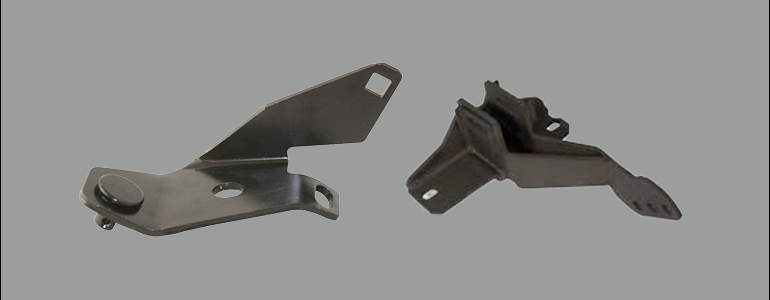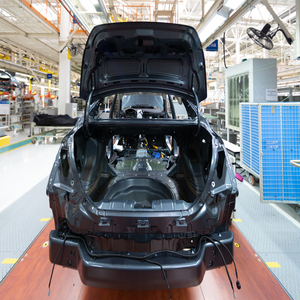A sway bar, also known as an anti-roll bar or stabilizer bar, is a component of a vehicle’s suspension system that helps to reduce the amount of body roll or sway during cornering.
It is typically a thin, hollow metal bar that is mounted to the suspension of a vehicle, and it works by connecting the left and right wheels together through a series of links.
The manufacturing process for sway bars typically begins with the selection of the appropriate material for the bar. Common materials include steel, aluminum, and carbon fiber, each of which has its own unique properties and benefits.
Next, the Sway Bar is shaped and sized to fit the specific vehicle it will be used on. This may involve bending the bar to match the shape of the suspension, or machining it to a specific diameter.
The sway bar is then finished by applying a coating, such as paint or powder coat, to protect it from corrosion and wear. It is then assembled with the necessary mounting brackets and links, and tested to ensure that it meets the required specifications.
Overall, the manufacturing process for sway bars involves a combination of fabrication, machining, and assembly, and it is typically carried out by specialized manufacturers using specialized equipment.
In simple words, the sway bar is part of your car’s suspension, which also includes your wheels and tires, springs, shocks, steering system, linkages, bushings, and joints. Sway bars help your vehicle turn and keep your body from leaning, which is the last thing you want when driving an RV or motor coach.
At its most basic, a sway bar is just a piece of metal that moves in response to a twisting movement. When your car turns, the sway bar works to keep everything level and stop that tilting feeling you may have felt when taking a corner too quickly.
The type and number of sway bars depend on the vehicle. The actual bar is attached from one wheel to the other across the body of the vehicle.
What does a Sway Bar do?
As was said above, the point of a sway bar is to stop the body of the car from leaning, which is usually caused by turning. When a car, especially a big one like a truck or motor coach, turns, the force goes to the outside (if you were turning right, force and weight would be naturally shifted to the left). This usually makes the tire on the outside rise higher than the tire on the inside. But with a sway bar, the tires are brought back to the same level, which brings the whole car back to the same level.
As a torsion spring, the sway bar responds to twisting motion (again, most often seen when turning) by bringing your vehicle’s wheels to the same height. On the other hand, if both tires hit something with the same force, there would be no twisting motion and no need for a sway bar.
The most obvious reason why sway bars are important is that they keep your car from rolling too much when turning. Aside from making the car safer, sway bars keep the wheels from being out of alignment and help the car keep a better grip on the road.
Working on a Sway Bar
The two wheels on the inside of the turn will rise, or the suspension will stretch. Just think: when you make a sharp turn, you can feel your body moving or drifting to the outside of the turn.
The next time you are turning a corner, think about how your body moves and imagine that your car is doing the same thing. This body roll is controlled by the sway bar.
The sway bar will push the tires on the inside of the turndown or compress the suspension of the inside wheel so that the tires stay in contact with the road and keep your car stable. The sway bar will spread the weight of your car across all four tires so that your car stays as flat as possible when you turn.
Functions
The anti-roll bar’s primary purpose is to lessen the body of the vehicle’s lean. Depending on the overall roll stiffness of the vehicle, body roll or lean can be reduced. The entire steady-state weight (load) transfer from the inner wheel to the outer wheel is unaffected by changes in the vehicle’s overall lean stiffness; only the body roll is reduced. The total lateral weight transfer is calculated using the track width and center of gravity height.
The sway bar also modifies the driving balance of the car. By altering the overall roll stiffness ratio between the front axle and rear axle, the oversteer or understeer phenomenon can be controlled.
The overall load shift ratio to which the front axle is responsive increases with an increase in the roll stiffness ratio of the front wheel, whereas the responsiveness ratio of the rear axle decreases.
The outside front wheels often turn with a relatively high slip angle, whereas the outside rear wheels typically turn with a relatively low slip angle as a result. Understeer is decreased when the rear axle roll stiffness ratio is increased, which has the opposite effect.
Why are Sway Bars Necessary?
Because stabilizer bars are most frequently used in vehicles, they guarantee safety. If the car turns too far in one direction, this bar might be dangerous.
Additionally, it helps keep the car from slipping when turning. Sway bars thereby stop the wheels from slipping, which could cause the driver to slide. This makes it more challenging to steer the car, especially when braking or turning.
The fact that not all cars can benefit from anti-roll bars, however, is one of their numerous drawbacks. One of the key signs of a defective anti-roll bar connection is a high, rigid anti-roll. When driving over bumps, the entire vehicle seems rigid as a result. The bike is more likely to hang up if it is excessively stiff.
The Sway Bar Manufacturing Process
Sway bars have been made using a variety of techniques over the years. The typical way to make a bar is to start with raw bar material and use a press and dies to bend it into the desired shape. There are a number of downsides to this approach, despite the fact that it is typically an inexpensive way to create them.
The first drawback is that each bend is completed independently. The tolerance, or manufacturing inaccuracy, increases with each bend. This permits more human error in the production process.
The packing of the sway bar gets more restrictive as trucks get more complicated. Since there is less tolerance for error, the component must be more precise to fit in the car.
Another drawback is that the press bends may leave the product with several severe tooling dents or “marks.” On a solid bar, dents like these are acceptable, but they detract from the part’s aesthetic appeal.
This conventional technique cannot be used to bend tubular material. When bending the material, the press will either kink or split the tubing.
Sway Bar Manufacturer in India – INDGIRKA
Sway bars are a very important sheet metal component because they play an important role in the automobile sector. Sway bars are like the backbone of the suspension in a car.
It is a very important factor that the quality and strength of the sway bar be high and durable because they carry a huge load on themselves. That’s why we at INDGIRKA manufacture the best sway bars at a comparative rate. We not only manufacture but also supply it around the world.





